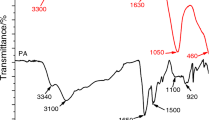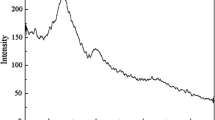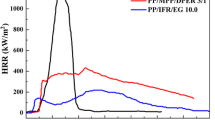Abstract
Aluminum trihydrate (ATH) of different sizes is added to polypropylene (PP) to prepare a composite which will have both good fire-retardant and mechanical properties. PP/ATH (nano or micro) composites are more fire-resistant and having appreciable mechanical properties as compared to virgin PP. Addition of maleic anhydride-functionalized polypropylene (MAPP) to the composite to increase the compatibility between PP and ATH (nano or micro). The need for developing the mechanical properties of flame-retardant composites is discussed in this paper. The influence of concentration of ATH (nano or micro) in PP/ATH (nano or micro)/MAPP composites is presented. The mechanical, thermal, morphological and flame-retardant properties were studied and discussed. The tensile modulus, hardness and flame-retardant properties increase, while elongation at break and tensile strength decreases with the increase in ATH (nano or micro) content.
Graphical abstract











Similar content being viewed by others
References
Shah R, Lee D, Wang Y, Wasy A, Ham KC, Jayaraman K. Effect of concentration of ATH on mechanical properties of Effect of concentration of ATH on mechanical properties of polypropylene/aluminium trihydrate (PP/ATH ) composite. Trans Nonferr Met Soc China Nonferr Met Soc China. 2014;24:s81–9. https://doi.org/10.1016/S1003-6326(14)63292-1.
Jeffrey I, Haley C, Us KY, Schneider C, De H, Ringham C, et al. Ter. 2019;1.
Mascia L. An overview of additives and modifiers for polymer blends: facts, deductions, and uncertainties. Adv Polym Technol J Polym Process Inst. 1992;11:237–48.
Nerea P, Qi X, Nie S, Acuña P, Chen M, Wang D. Flame retardant polypropylene composites with low densities. 2019;1–11.
Laoutid F, Bonnaud L, Alexandre M, Lopez-Cuesta JM, Dubois P. New prospects in flame retardant polymer materials: from fundamentals to nanocomposites. Mater Sci Eng R Rep. 2009;63:100–25.
Farzad RH, Hassan A, Jawaid M, Piah MAM. Mechanical properties of alumina trihydrate filled polypropylene/ethylene propylene diene monomer composites for cable applications. Sains Malaysiana. 2013;42:801–10.
Idumah CI. Emerging advancements in flame retardancy of polypropylene nanocomposites. J Thermoplast Compos Mater. 2020;089270572093078.
Wang L, Zhang M, Zhou B. Thermal stability, combustion behavior, and mechanical property in a flame-retardant polypropylene system. Appl Sci. 2017;7:55.
El-Sabbagh A, Steuernagel L, Meiners D, Ziegmann G, Toepfer O. Optimization of flame retardant content with respect to mechanical properties of natural fiber polymer composites: case study of polypropylene/flax/aluminum trihydroxide. Polym Compos. 2016;37:3310–25. https://doi.org/10.1002/pc.23530.
Beltrán-Ramírez FI, Ramos-deValle LF, Ramírez-Vargas E, Sánchez-Valdes S, Espinoza-Martínez AB, Martínez-Colunga JG, et al. Effect of Nanometric Metallic Hydroxides on the Flame Retardant Properties of HDPE Composites. Journal of Nanomaterials. 2014;2014:1–11. http://www.hindawi.com/journals/jnm/2014/969184/
Sabaruddin FA, Samat N, Habibah AIHD. The effects of coupling agent on the flame retardant properties of PP/ATH the effects of coupling agent on the flame retardant properties of PP/ATH nanocomposites. 2017.
Agarwal J, Mohanty S, Nayak SK. Influence of cellulose nanocrystal/sisal fiber on the mechanical, thermal, and morphological performance of polypropylene hybrid composites. Polym Bull. 2021;78:1609–35. https://doi.org/10.1007/s00289-020-03178-4.
Faghihi J, Morshedian J, Ahmadi S. Effect of fillers on the fire retardant properties of intumescent polypropylene compounds. Polym Polym Compos. 2008;16:315–22.
Zhang J, Shields TJ, Silcock GWH. Effect of melting behaviour on upward flame spread of thermoplastics. Fire Mater. 1997;21:1–6.
Li M, Zhang Z, Wu L, Zhang Y, Mai K. β-Crystallization and mechanical properties of aluminum hydroxide-filled polypropylene composites. Polym Compos. 2019;40:E194-201.
Agarwal J, Mohanty S, Nayak SK. Valorization of pineapple peel waste and sisal fiber: study of cellulose nanocrystals on polypropylene nanocomposites. J Appl Polym Sci. 2020;137:1–19.
Hippi U, Mattila J, Korhonen M, Seppälä J. Compatibilization of polyethylene/aluminum hydroxide (PE/ATH) and polyethylene/magnesium hydroxide (PE/MH) composites with functionalized polyethylenes. Polymer. 2003;44:1193–201.
Funding
Funding was provided by Ministry of Mines, Govt. of India, India (Grant No. Met4-14/17/2018-Met.IV).
Author information
Authors and Affiliations
Corresponding author
Additional information
Publisher's Note
Springer Nature remains neutral with regard to jurisdictional claims in published maps and institutional affiliations.
Rights and permissions
Springer Nature or its licensor (e.g. a society or other partner) holds exclusive rights to this article under a publishing agreement with the author(s) or other rightsholder(s); author self-archiving of the accepted manuscript version of this article is solely governed by the terms of such publishing agreement and applicable law.
About this article
Cite this article
Parida, M.R., Mohanty, S., Biswal, M. et al. Influence of aluminum trihydrate (ATH) particle size on mechanical, thermal, flame retardancy and combustion behavior of polypropylene composites. J Therm Anal Calorim 148, 807–819 (2023). https://doi.org/10.1007/s10973-022-11851-1
Received:
Accepted:
Published:
Issue Date:
DOI: https://doi.org/10.1007/s10973-022-11851-1




